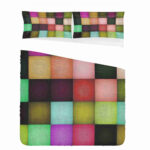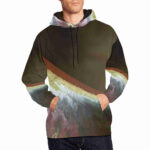Color Psychology – Using Colors for Your Personal Style

Color Psychology
Did you know that colors have a powerful impact on human behavior, emotions, moods, and attitudes? Color psychology is a fascinating field that seeks to understand how different colors can evoke strong feelings and associations in people, which can be used in various ways to influence behavior, from calming and soothing to energizing and invigorating.
Research has shown that people can experience physical and emotional responses to certain colors. For instance, blue is often associated with feelings of calmness and tranquility, while red is associated with passion and excitement. Here are some common associations that people have with different colors:
Red color: This is a bold and powerful color that can evoke feelings of passion, excitement, and energy. It can also be associated with anger and danger. Red is also seen as a powerful and bold color that can elicit confidence and courage. Personality: Passionate, energetic, excited, dangerous, confident.
Orange color: This is a warm and friendly color that can create feelings of happiness, enthusiasm, and creativity. It can also be associated with over-stimulation and restlessness. Personality: Warm, friendly, enthusiastic, creative.
Yellow color: This is a bright and cheerful color that can evoke feelings of joy, optimism, and confidence. It can energize and stimulate mental activity, making it a good choice for work or study. It can also be associated with caution and anxiety. Personality: Happy, optimistic, intellectual, cautious.
Green color: This is a calming and soothing color that can create feelings of relaxation, balance, and harmony. It is also linked to growth and renewal, promoting a sense of freshness and optimism. It can also be associated with jealousy and envy. Personality: Nature-lover, mature, freshness, peace-loving, wealthy.
Blue color: This is a cool and calming color that can evoke feelings of serenity, trust, and loyalty. It has a soothing effect on the mind and body and can help reduce stress and anxiety. It can also be associated with sadness and depression. Personality: Calm, trustworthy, serene, intelligent, stable
Purple color: This is a rich and luxurious color that can create feelings of creativity, spirituality, and royalty. It can also be associated with arrogance and decadence. Personality: Royalty, luxurious, creative, spiritual.
Pink color: This is a soft and gentle color that can evoke feelings of love, compassion, and nurturing. It can also be associated with weakness and vulnerability. Personality: Loving, feminine, nurturing, playful.
Brown color: This is an earthy and grounding color that can create feelings of stability, security, and reliability. It can also be associated with dullness and boredom. Personality: Earthy, rugged, reliable, warm, mature.
Black color: This is a sophisticated and powerful color that can evoke feelings of elegance, mystery, and authority. It can give off an air of power and authority, but it can also be associated with negativity, death and mourning. Personality: Powerful, sophisticated, elegant, mysterious, melancholic.
White color: This is a pure and innocent color that can create feelings of simplicity, cleanliness, and peace. But it can also be seen as empty, sterile or cold. Personality: Pure, clean, peaceful, simple, empty, cold.
The way you perceive colors can vary depending on your culture, personal experience, and context. For example, in Western cultures, white is often associated with purity and weddings, while in Eastern cultures it is associated with mourning and funerals.
That’s why it’s essential to consider your individual preferences and associations when applying color psychology in your personal life. Choose colors that make you feel comfortable and confident, rather than solely relying on their perceived effects on mood and behavior.
Colors can also be used in interior design to create specific moods and atmospheres within a space. For instance, blue is often used in bedrooms and bathrooms because it creates a calming, relaxed environment. On the other hand, red is rarely used in bedrooms because it is too stimulating and can interfere with sleep. So even though you may have a passionate red personality, when it comes to rest and relaxation, you may need to invoke another personality!
In addition to affecting mood and behavior, color psychology can also impact cognitive performance. Research has shown that certain colors can improve memory retention and recall, while others can hinder it. For example, the color yellow has been found to enhance memory and concentration, while the color green has been found to reduce fatigue and improve reading speed.
Part of the reason why colors have such a profound effect on us is because they are deeply ingrained in our cultural and personal experiences. For example, the color white may be associated with purity and innocence in Western cultures, but in some Eastern cultures it is associated with death and mourning. The color black is often seen as sophisticated and elegant, but it can also be associated with negative emotions like fear and sadness.
The psychological effects of color are also influenced by context. For example, the color red can inspire feelings of love and passion when used in a romantic setting, but it can also signify danger and warning when used in a traffic sign. Similarly, the color green can be associated with nature and growth, but it can also signify envy and jealousy.
A common approach to studying color psychology is through color association tests, in which participants are shown a series of colors and asked to associate them with specific emotions or concepts. By analyzing the responses, researchers can gain valuable insights into the associations people have with different colors and how they vary across cultures and contexts.
In addition to color association tests, another popular tool for studying color psychology is the use of color preference surveys. These surveys ask participants to rate their preferred colors and explain why they like them. Through this research, psychologists have found that there are some universal preferences for certain colors, such as blue and green, which are often associated with calmness and nature.
While color psychology can offer valuable insights into human behavior and emotions, it is important to remember that color preferences and associations can vary greatly from person to person. Personal experiences, cultural backgrounds, and individual personalities can all play a role in shaping how we perceive and react to different colors, including choosing a color as our ‘favorite’.
Colors for Your Personal Style
Colors play a significant role in personal style, whether it’s your wardrobe, makeup or accessories. Choosing the right colors can make you feel confident, put-together, and showcase your unique personality. How to use colors effectively for personal style.
- Determine Your Skin Tone
Before choosing colors for your personal style, regardless if you’re a man or a woman, it’s important to determine your skin tone. There are two main categories – cool and warm. Cool skin tones tend to have pink or bluish undertones, while warm skin tones have yellow or golden undertones.
- Choose Colors That Compliment Your Skin Tone
Once you’ve determined your skin tone, choose colors that compliment it. Cool skin tones tend to look best in jewel tones like emerald green, sapphire blue, and ruby red, as well as pastel shades of blue and pink. Warm skin tones tend to look best in earthy tones like olive green, rust, and mustard yellow, as well as shades of orange and brown.
- Play With Color Contrast
Contrast is an essential element of personal style. You can create contrast by pairing light colors with dark colors, or bright colors with neutral tones. Experiment with different color combinations to see what works best for you.
- Mix and Match Different Colors
Mixing light and dark shades or brights with neutrals can create a whole new level of interest in your style. Don’t be afraid to mix and match different colors to create a unique and personalized look. You can even create a color scheme for your wardrobe to make sure everything matches and flows together together nicely.
- Consider The Occasion
Consider the occasion when choosing colors for your personal style. For example, bright and bold colors may not be appropriate for a formal event, while muted tones may not work for a casual outing. Be sure to choose colors that match the setting and vibe of the occasion.
Using colors effectively in your personal style is a wonderful way to express yourself and feel amazing. By determining your skin tone, choosing colors that compliment it, playing with color contrast, mixing and matching different colors, and considering the occasion, you can create a unique and personalized style that expresses your personality and makes you feel confident.
 Travel Backpack
Travel Backpack Mouth Mask
Mouth Mask Balaclava
Balaclava Multipurpose Headgear Face Mask
Multipurpose Headgear Face Mask Bedding
Bedding Bed Set
Bed Set Blanket
Blanket Duvet Cover
Duvet Cover Jigsaw Puzzle Wall Art
Jigsaw Puzzle Wall Art Mug
Mug Travel Mug
Travel Mug Wall Clock
Wall Clock Arabic Calligraphy
Arabic Calligraphy Arabic Numerals
Arabic Numerals Roman Numerals
Roman Numerals Wooden Clock
Wooden Clock Mens Blanket Hoodie
Mens Blanket Hoodie Mens Hoodie
Mens Hoodie Mens Long Sleeve T shirt
Mens Long Sleeve T shirt Mens T-Shirt
Mens T-Shirt Mens Polo Shirt
Mens Polo Shirt Mens Windbreaker
Mens Windbreaker Subliminal Tie
Subliminal Tie Mens Wallet
Mens Wallet Baraka Blessed Mens Wallet
Baraka Blessed Mens Wallet Pop Art Mens Wallet
Pop Art Mens Wallet Arabic Calligraphy Womens Wallet
Arabic Calligraphy Womens Wallet Womens Trifold Wallet
Womens Trifold Wallet Sport Watch
Sport Watch Womens Blanket Hoodie
Womens Blanket Hoodie Womens Hoodie
Womens Hoodie Womens Long Sleeve T shirt
Womens Long Sleeve T shirt